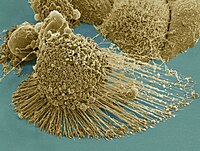
Photo from wikipedia
Objective To establish an immortalized human periodontal ligament stem cell line (hPDLSC) and investigate whether and how YAP mediates the establishment of the stem cell line. Methods Primary hPDLSCs were… Click to show full abstract
Objective To establish an immortalized human periodontal ligament stem cell line (hPDLSC) and investigate whether and how YAP mediates the establishment of the stem cell line. Methods Primary hPDLSCs were cultured and transfected with lentivirus containing the telomerase reverse transcriptase (TERT) gene. The expression of TERT was detected via the polymerase chain reaction (PCR) and real-time quantitative PCR (RT-PCR). Flow cytometry was employed to detect surface markers of hPDLSCs and TERT-hPDLSCs. The cell counting kit-8 (CCK-8) and 5-ethynyl-2'-deoxyuridine (EdU) methods were used to examine the proliferation ability of the cells. Flow cytometry and TUNEL staining were employed to examine the cell apoptosis rate. The β-galactosidase staining assay was used to assess the rate of cell senescence. The osteogenic differentiation ability of the cells was detected via alkaline phosphatase (ALP) staining and Alizarin red staining assays. BALB/c mice were employed to determine the tumorigenicity of TERT-hPDLSCs. The expression levels of YAP and other proteins in the Hippo signaling pathway were detected by Western blotting. Verteporfin was used to inhibit the binding of YAP to the downstream target gene TEAD. Results TERT-hPDLSCs showed stable high expression of TERT, even at the thirtieth passage after transfection with lentivirus containing the TERT gene. Compared with primary hPDLSCs, TERT-hPDLSCs exhibited a stronger proliferation ability and lower cell apoptosis and senescence rates while maintaining the same osteogenetic differentiation ability as primary hPDLSCs. The transfection of hPDLSCs with lentivirus containing the TERT gene did not lead to tumorigenesis in nude mice. The Hippo signaling pathway was inactivated in TERT-hPDLSCs compared to hPDLSCs. When treated with verteporfin, the proliferation of TERT-hPDLSCs decreased, while the apoptosis and senescence rates of these cells increased. However, TERT-hPDLSCs still showed a stronger proliferation ability and lower cell apoptosis and senescence rates than hPDLSCs treated with verteporfin at the same concentration. Conclusions Overexpression of TERT in hPDLSCs resulted in the successful establishment of an immortalized periodontal ligament stem cell line. TERT may regulate the biological characteristics of hPDLSCs through the Hippo/YAP signaling pathway. hPDLSCs could be a feasible resource for stem cell research and a promising resource for stem cell therapy.
Journal Title: Stem Cells International
Year Published: 2019
Link to full text (if available)
Share on Social Media: Sign Up to like & get
recommendations!